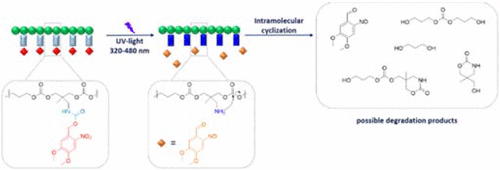当前位置:
X-MOL 学术
›
Biomacromolecules
›
论文详情
Our official English website, www.x-mol.net, welcomes your
feedback! (Note: you will need to create a separate account there.)
Use of Light-Degradable Aliphatic Polycarbonate Nanoparticles As Drug Carrier for Photosensitizer
Biomacromolecules ( IF 5.5 ) Pub Date : 2018-11-15 00:00:00 , DOI: 10.1021/acs.biomac.8b01446 Jingjiang Sun 1, 2 , Wolfgang Birnbaum 1 , Juliane Anderski 3 , Marie-Theres Picker 1 , Dennis Mulac 3 , Klaus Langer 3 , Dirk Kuckling 1
Biomacromolecules ( IF 5.5 ) Pub Date : 2018-11-15 00:00:00 , DOI: 10.1021/acs.biomac.8b01446 Jingjiang Sun 1, 2 , Wolfgang Birnbaum 1 , Juliane Anderski 3 , Marie-Theres Picker 1 , Dennis Mulac 3 , Klaus Langer 3 , Dirk Kuckling 1
Affiliation

|
Aliphatic poly(carbonate)s (APCs) with rapid and controlled degradation upon specific stimulation have great advantages for a variety of biomedical and pharmaceutical applications. In the present work, we reported a new poly(trimethylene carbonate) (PTMC)-based copolymer containing multiple 4,5-dimethoxy-2-nitrobenzyl photo cleavable groups as pendent chains. The six-membered light-responsive cyclic carbonate monomer (LrM) was first prepared from 2-(hydroxymethyl)-2-methylpropane-1,3-diol and 4,5-dimethoxy-2-nitrobenzyl alcohol and then copolymerized with trimethylene carbonate (TMC) by 1,8-diazabicyclo(5.4.0)undec-7-ene (DBU) catalyzed ring-opening polymerization (ROP) to afford the light-responsive polycarbonate (LrPC). The light-triggered decomposition of LrM and LrPC was studied by NMR, UV/vis spectroscopy, and size exclusion chromatography (SEC), as well as ESI-ToF mass spectrometry. Stable monodisperse nanoparticles with hydrodynamic diameter of 100 nm could be formulated from 25% LrPC and 75% poly(lactide-co-glycolide) (PLGA) and applied for the encapsulation of temoporfin. Upon irradiation with UV light these particles displayed a significant decrease of the particle countrate and increased the release rate of temoporfin in comparison to standard PLGA nanoparticles. This work demonstrated that a combination of encapsulation of photosensitizer and light degradation using light-responsive polymers is suitable to enhance photodynamic therapy (PDT).
中文翻译:

可光降解的脂肪族聚碳酸酯纳米粒子作为光敏剂的药物载体的用途
在特定刺激下具有快速可控降解的脂肪族聚碳酸酯(APC)对于多种生物医学和制药应用具有巨大优势。在目前的工作中,我们报道了一种新型的聚碳酸三亚甲基酯(PTMC)基共聚物,其中含有多个4,5-二甲氧基-2-硝基苄基光可裂解基团作为侧链。首先由2-(羟甲基)-2-甲基丙烷-1,3-二醇和4,5-二甲氧基-2-硝基苄醇制备六元光响应性环状碳酸酯单体(LrM),然后将其与碳酸三亚甲基酯(通过1,8-二氮杂双环(5.4.0)十一碳-7-烯(DBU)催化的开环聚合(ROP),得到光响应性聚碳酸酯(LrPC)。LrM的光触发分解和LRPC通过NMR,UV / vis光谱研究,和大小排阻层析(SEC),以及ESI-TOF质谱。可以用25%LrPC和75%聚(丙交酯-共-乙交酯)(PLGA)配制具有100 nm流体力学直径的稳定单分散纳米颗粒,并将其用于替莫泊芬的封装。与标准PLGA纳米粒子相比,在用紫外线照射后,这些粒子显示出粒子计数率显着降低,并增加了替莫泊芬的释放速率。这项工作表明,使用光响应性聚合物将光敏剂封装和光降解相结合,可以增强光动力疗法(PDT)。
更新日期:2018-11-15
中文翻译:

可光降解的脂肪族聚碳酸酯纳米粒子作为光敏剂的药物载体的用途
在特定刺激下具有快速可控降解的脂肪族聚碳酸酯(APC)对于多种生物医学和制药应用具有巨大优势。在目前的工作中,我们报道了一种新型的聚碳酸三亚甲基酯(PTMC)基共聚物,其中含有多个4,5-二甲氧基-2-硝基苄基光可裂解基团作为侧链。首先由2-(羟甲基)-2-甲基丙烷-1,3-二醇和4,5-二甲氧基-2-硝基苄醇制备六元光响应性环状碳酸酯单体(LrM),然后将其与碳酸三亚甲基酯(通过1,8-二氮杂双环(5.4.0)十一碳-7-烯(DBU)催化的开环聚合(ROP),得到光响应性聚碳酸酯(LrPC)。LrM的光触发分解和LRPC通过NMR,UV / vis光谱研究,和大小排阻层析(SEC),以及ESI-TOF质谱。可以用25%LrPC和75%聚(丙交酯-共-乙交酯)(PLGA)配制具有100 nm流体力学直径的稳定单分散纳米颗粒,并将其用于替莫泊芬的封装。与标准PLGA纳米粒子相比,在用紫外线照射后,这些粒子显示出粒子计数率显着降低,并增加了替莫泊芬的释放速率。这项工作表明,使用光响应性聚合物将光敏剂封装和光降解相结合,可以增强光动力疗法(PDT)。











































 京公网安备 11010802027423号
京公网安备 11010802027423号